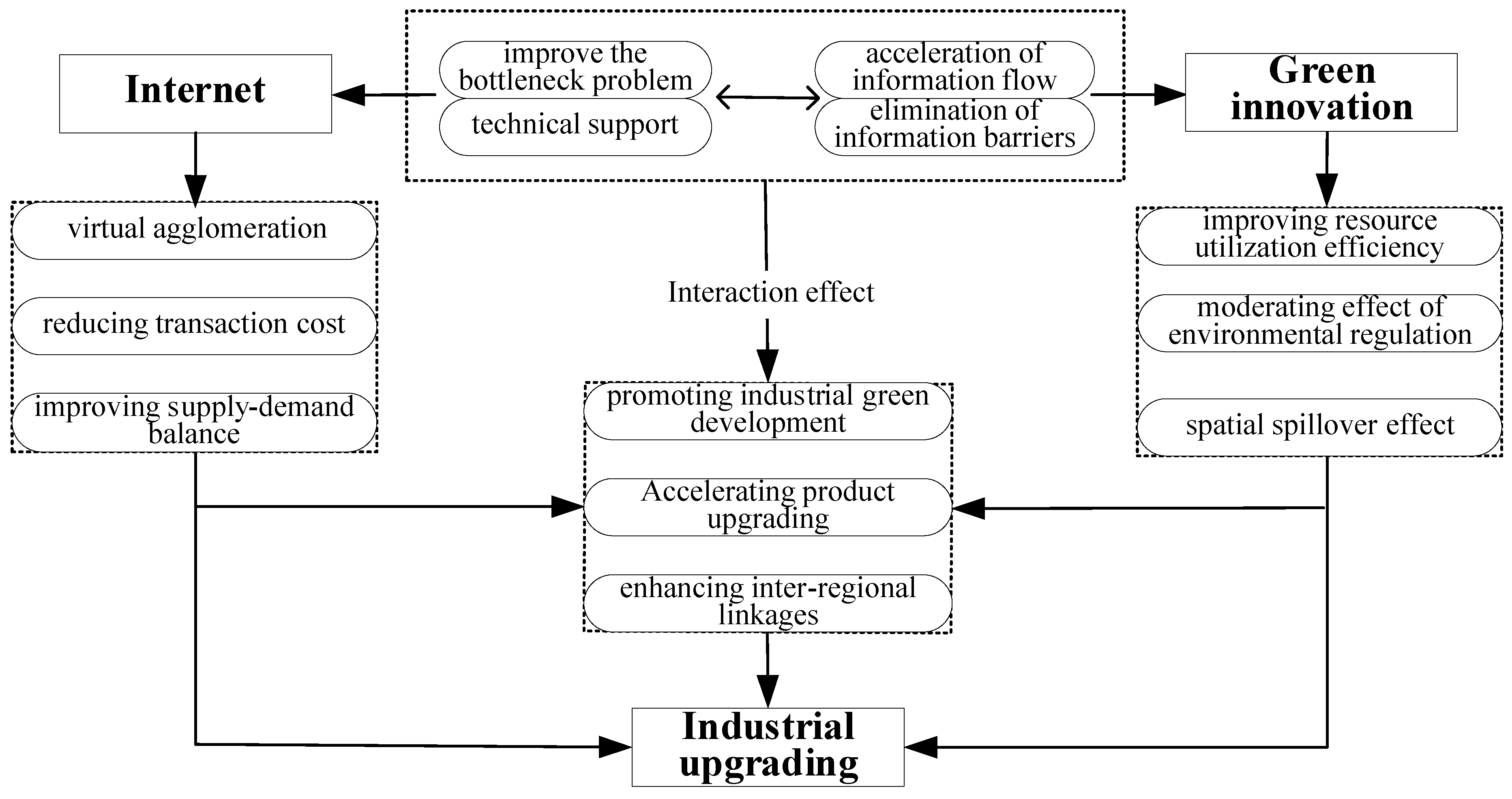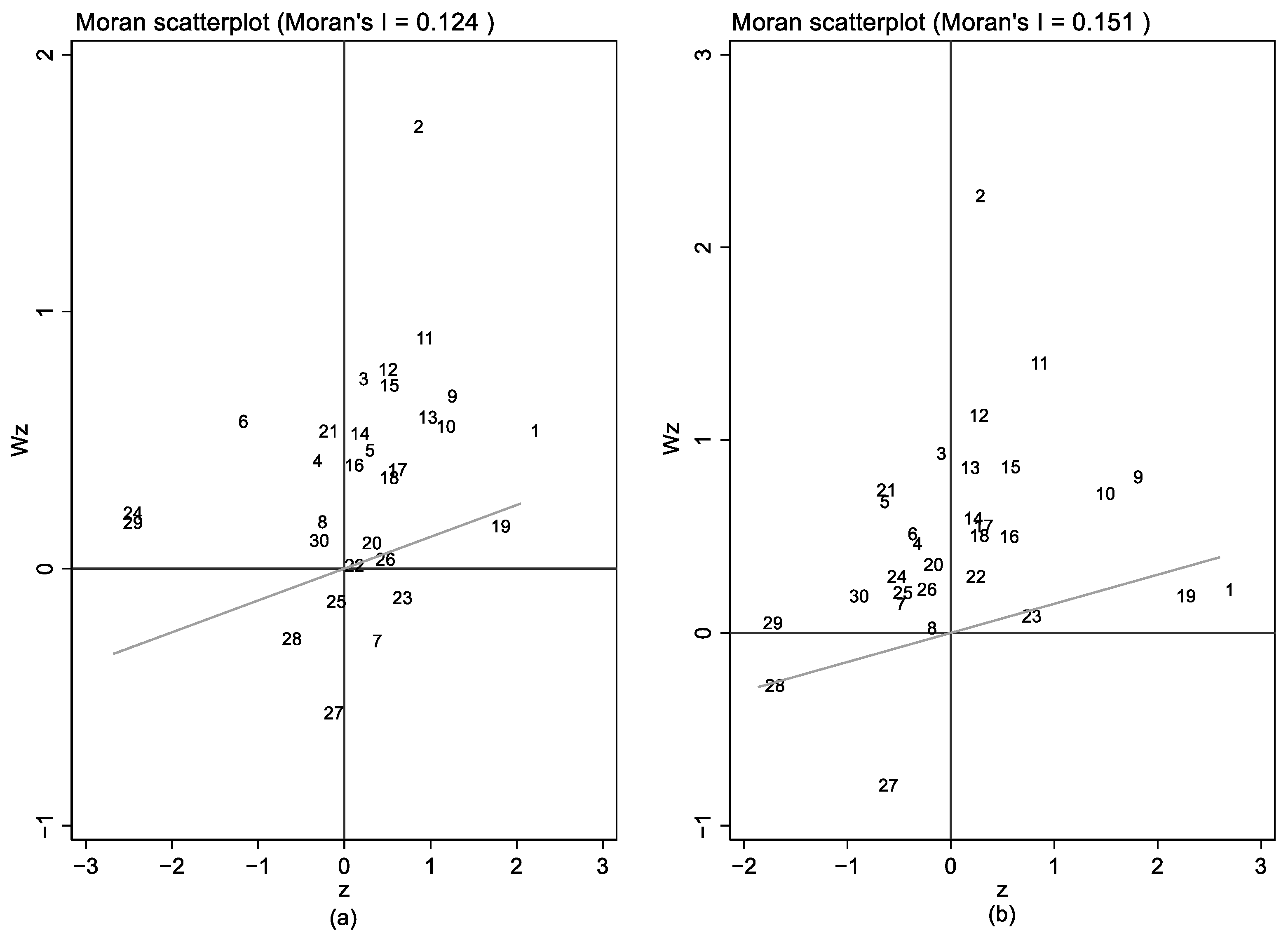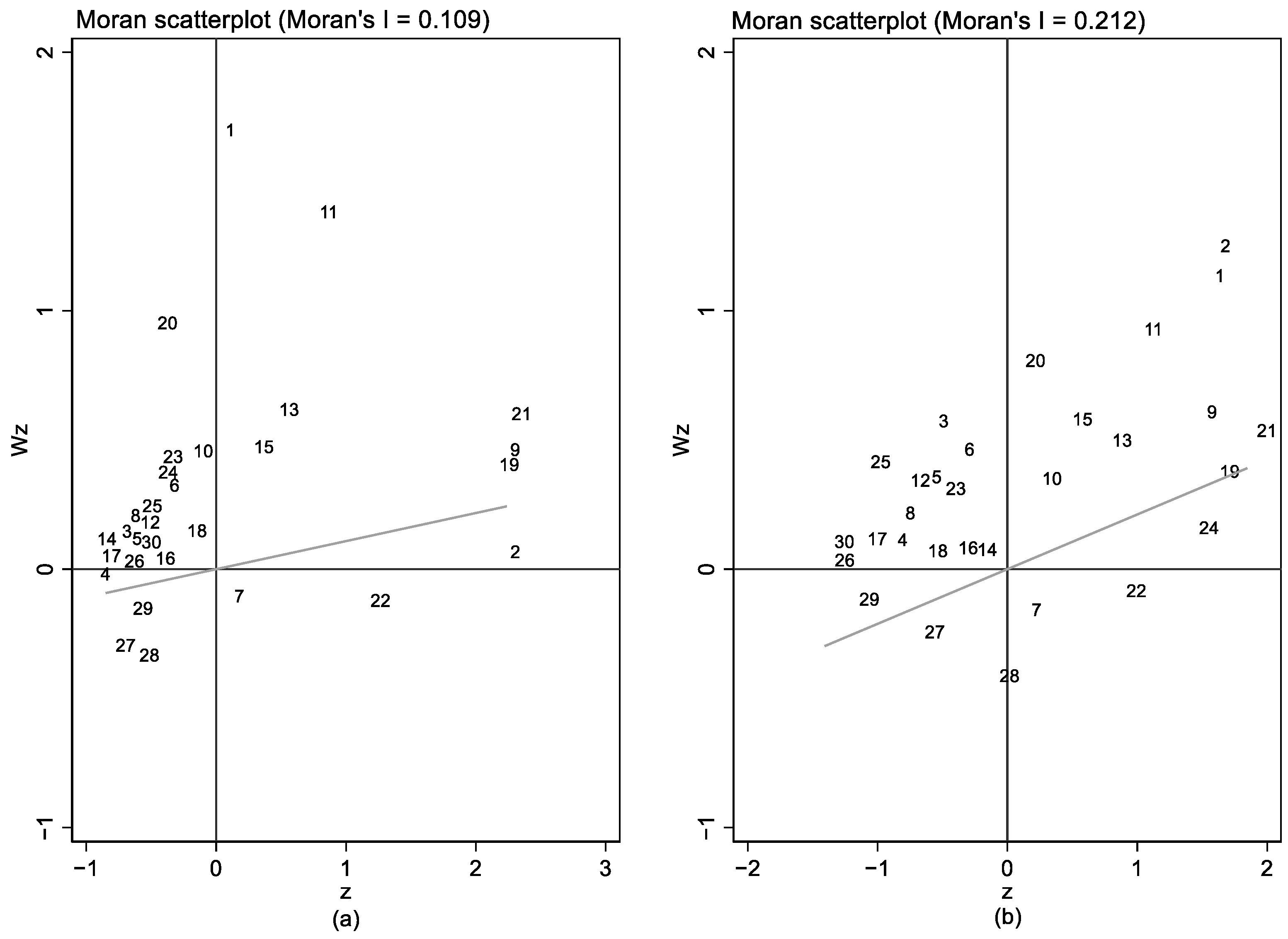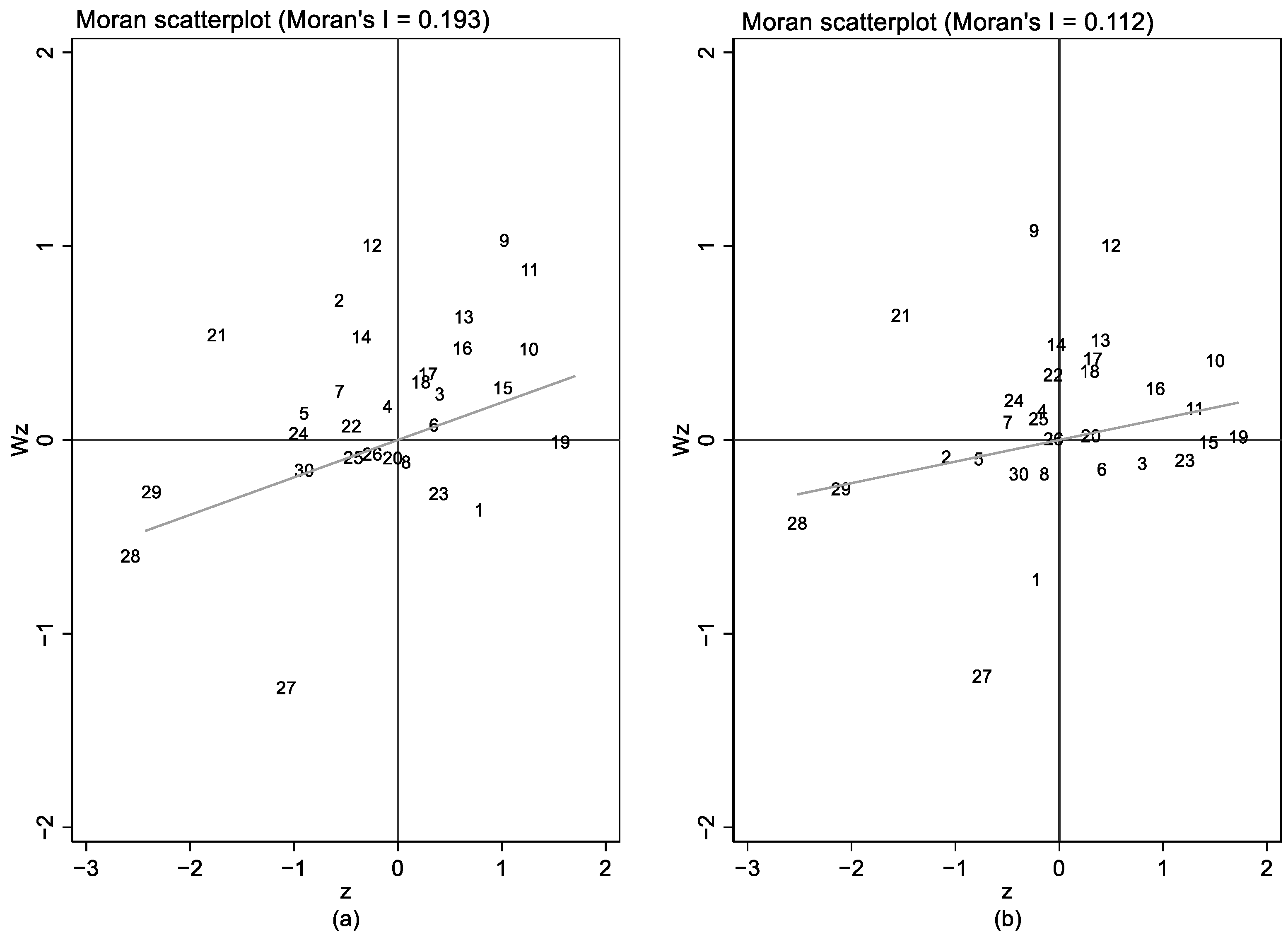Internet, Green Innovation and Industrial Upgrading
Abstract
1. Introduction
2. Literature Review
3. Theoretical Mechanisms and Theoretical Hypotheses
3.1. The Internet Promotes Industrial Upgrading
3.2. Green Innovation Promotes Industrial Upgrading
3.3. The Interaction between Internet and Green Innovation Promotes Industrial Upgrading
4. Variable Measurement and Model Establishment
4.1. Variable Measurement
4.1.1. Explained Variable—Industrial Upgrading
4.1.2. Explanatory Variable—Green Innovation
4.1.3. Explanatory Variable—Internet
4.1.4. Control Variables
4.1.5. Data Sources
4.2. Spatial Econometrics Method
4.2.1. Setting of the Spatial Weight Matrix
4.2.2. Spatial Autocorrelation Test
4.2.3. Spatial Panel Measurement
5. Empirical Results and Analysis
5.1. Spatial Autocorrelation Analysis
5.2. Model Selection
5.3. Spatial Regression Results
5.3.1. Analysis for the Whole Sample
5.3.2. Analysis for Regional Sample
6. Discussion and Conclusions
6.1. Discussion
6.2. Main Conclusions
- The internet, green innovation, and industrial upgrading had significant positive spatial correlation during the study period; namely, their development was affected by both the local and adjacent areas. The main spatial agglomeration trends on the internet, green innovation, and industrial upgrading were shown as spatial trends of high–high and low–high agglomeration. Among them, most of the regions represented high–high agglomeration trends for industrial upgrading and were mainly located in the eastern and central regions. This is similar to the internet, which mainly presented high–high agglomeration trends. Most regions with high–high agglomeration were located in the Yangtze Delta region. On the other hand, green innovation mainly presented low–high agglomeration spatial trends. During the period, most regions changed from low–high agglomeration to high–high agglomeration and from low–low agglomeration to low–high agglomeration.
- In the independent-effect test, both the internet and green innovation significantly enhanced industrial upgrading. No matter which spatial weight matrix was used, the internet coefficient was significantly greater than the green innovation coefficient. This indicates that the internet independent effect on industrial upgrading is higher than the green-innovation independent effect. The cross-term coefficients of the internet and green innovation based on the four spatial weight matrixes were significantly positive, indicating that there is an interactive effect between the internet and green innovation on industrial upgrading. Besides, the cross-term effects were similar to the independent effects of the internet and green innovation, which are more closely related to the economic development among in the four spatial weight matrixes.
- Regardless of the region, the internet, green innovation, and their cross-term played a positive role in promoting industrial upgrading. However, there were still difference in the three regions when it came to the independent effects and interactive effect. Only in the western region was the independent effect of the internet more significant than the synergistic effect. Based on the coefficients of the internet and green innovation in the western region, the development of green innovation lagged behind the internet. This was similar in the central region; the development of the internet was better than green innovation. In the eastern region, the coefficient of the internet was lower than green innovation, which was different from the central and western regions.
6.3. Policy Recommendations
- Continuously and efficiently promote the construction, promotion, and application of the internet. The government should increase investment in internet-infrastructure construction, encourage and guide enterprises to “touch the internet” and “use the internet”, improve the construction of supporting systems in standards and security such as data property right protection and platform architecture, and build an industrial-internet network-construction system covering all regions and industries.
- Optimize the green innovation environment. The government should accelerate the establishment and optimization of a cooperative-innovation mechanism of government, industry, university, research, and application; strengthen the protection of intellectual property rights; and guide enterprises to meet market demands by providing products or services to form a model of market-demand-oriented technological innovation to make up for the shortcomings of green innovation and enhance the ability of green innovation.
- Take the “Internet + green innovation” strategy as a foothold to fully give way to the interactive effect of internet and green innovation. The government should accelerate the formulation of “Internet + green innovation” support policies, build a multidirectional collaborative innovation platform for the internet plus green innovation, and vigorously guide social capital to invest in the core areas of internet plus green innovation spillover so as to achieve high-quality integration of the internet plus green innovation.
- Implement internet-plus-green-innovation policies adapted to local conditions. For the eastern region, the development of the internet should be accelerated to improve the synergistic effect between the internet and green innovation, whereas the development of green innovation should be accelerated to enhance the effect of the internet plus green innovation in the western and central regions.
- Pay attention to the initiative and flexibility of the internet and green innovation in industrial restructuring to maximize the synergy effect. The internet and green innovation can show a dynamic characteristic of a positive and increasingly marginal effect with the improvement of industrial development. Thus, governments at all levels should adhere to the principle of dynamic management, adjust their policy implementation efforts to maintain a dynamic balance between the internet and green innovation, and promote the maximization of synergies.
6.4. Limitations and Future Directions
Author Contributions
Funding
Institutional Review Board Statement
Informed Consent Statement
Data Availability Statement
Conflicts of Interest
References
- Zhang, H.Y.; Geng, C.X. Analysis on the regional difference and convergence of the coupling of green innovation environment and industrial transformation and upgrading. Sci. Technol. Progr. Policy 2021, 38, 36–45. [Google Scholar]
- Ge, T.; Cai, X.S.; Song, X.W. How does renewable energy technology innovation affect the upgrading of industrial structure? The moderating effect of green finance. Renew. Energy 2022, 197, 1106–1114. [Google Scholar] [CrossRef]
- Lai, Y.F.; Ye, L.T.; Xie, P.J.; Ma, X.R. The coupling coordination of regional science & technology innovation and digital economy. Sci. Technol. Progr. Policy 2022, 39, 31–41. [Google Scholar]
- Cui, R.; Li, G.F. Regional differences and distributional dynamics of internet level in China: 2006~2018. J. Quant. Technol. Econ. 2021, 38, 3–20. [Google Scholar]
- Chen, B.; Wang, W.L. Internet development, industrial agglomeration structure, and green innovation efficiency. East China Econ. Manag. 2021, 35, 42–56. [Google Scholar]
- Arfi, W.B.; Hikkerova, L.; Sahut, J.M. External knowledge sources, green innovation and performance. Technol. Forecast. Soc. Change 2018, 129, 210–220. [Google Scholar] [CrossRef]
- Wang, F.Y.; He, Z.L. Environmental regulation, green innovation and industrial structure upgrading. Stat. Dec. 2022, 38, 73–76. [Google Scholar]
- Zheng, J.J.; Shao, X.F.; Liu, W.; Kong, J.; Zou, G.S. The impact of the pilot program on industrial structure upgrading in low-carbon cities. J. Clean Prod. 2021, 290, 125868. [Google Scholar] [CrossRef]
- Yu, X.; Wang, P. Economic effects analysis of environmental regulation policy in the process of industrial structure upgrading: Evidence from Chinese provincial panel data. Sci. Total Environ. 2020, 753, 142004. [Google Scholar] [CrossRef]
- Li, M.S.; Guan, S. Does China’s state-owned sector lead industrial transformation and upgrading? J. Clean Prod. 2022, 338, 130412. [Google Scholar] [CrossRef]
- Zhang, M.X.; Guo, X.X.; Li, Y.H. Research on the mechanism of the reflux of overseas high-end consumption on digital and intelligent upgrade of Chinese industry. World Econ. Stud. 2020, 1, 107–120. [Google Scholar]
- Lin, T.; Tan, W.Z. Review on regional industrial upgrading and a framework of upgrading dimensions. Areal Res. Dev. 2007, 5, 16–23. [Google Scholar]
- Guan, S.; Liu, J.Q.; Liu, Y.F.; Du, M.Z. The nonlinear influence of environmental regulation on the transformation and upgrading of industrial structure. Int. J. Environ. Res. Public Health 2022, 19, 8378. [Google Scholar] [CrossRef] [PubMed]
- Yang, D.; Zhou, P.P.; Zhou, Y.Q. Research on the mechanism of high-quality development of the industry influenced by green innovation and environmental regulation: Based on regulatory effects and threshold effects. Inq. Into Econ. Issues 2020, 11, 121–131. [Google Scholar]
- Zheng, H.; Liu, X.D.; Xu, Y.J.; Mu, H.R. Economic spillover effects of industrial structure upgrading in China’s coastal economic rims. Sustainability 2021, 13, 3855. [Google Scholar] [CrossRef]
- Lu, F.C.; Ma, S.X.; Xu, B. 70 years of industrialization in new China: From takeoff to maturity. Contemp. Financ. Econ. 2019, 10, 3–14. [Google Scholar]
- Lu, M.Y.; Chen, L. Analysis of the impact of “Internet plus” on the ecological transformation of industrial structure: Based on the data from 2000 to 2013 in Shanghai. Shanghai J. Econ. 2016, 9, 110–121. [Google Scholar]
- Huang, Z.; Wan, J.X. The influence of “Internet plus” and the upgrading of industry industrial structure: A case study of Shanghai. Sci. Technol. Manag. Res. 2018, 38, 81–87. [Google Scholar]
- Liu, Z.D.; Zhang, X. Internet development, marketization level and transformation and upgrade of China’s industrial structure. Res. Econ. Manag. 2021, 42, 22–34. [Google Scholar]
- Shi, B.Z.; Li, J.T. Does the internet promote division of labor? Evidences from Chinese manufacturing enterprises. Manag. World 2020, 36, 130–149. [Google Scholar]
- Lu, F.C.; Xu, Y.B. The impact of the internet on the development of productive service industries: From the perspective of transaction cost. Contemp. Financ. Econ. 2018, 12, 92–102. [Google Scholar]
- Bai, L.H.; Xue, Q.X.; Cao, W. Can “Internet+” drive the transformation and upgrading of traditional industries. Econ. Probl. 2021, 3, 86–91. [Google Scholar]
- Cui, Y.; Sun, Y. Research on relationship between internet infrastructure and optimization of industrial structure in China. Sci. Technol. Progr. Policy 2021, 38, 64–71. [Google Scholar]
- Raisch, S.; Krakowski, S. Artificial intelligence and management: The automation-augmentation paradox. Acad. Manage. Rev. 2021, 46, 192–210. [Google Scholar] [CrossRef]
- Xu, W.C.; Fan, A.J. China’s industrial structure upgrade driven by “Internet+” strategy. Financ. Econ. 2018, 3, 119–132. [Google Scholar]
- Gao, H.G.; Xiao, T. Can heterogeneous environmental regulation force industrial structure optimization: Based on the intermediary and threshold effects of green technology innovation efficiency of industrial enterprises. Jianghan Trib. 2022, 3, 13–21. [Google Scholar]
- Xie, C.Q.; Ye, L.W.; Sun, D.; Liu, L.H. Outward foreign investment, reverse green technology innovation and industrial upgrading based on the moderated mediating effect. Sci. Technol. Manag. Res. 2022, 42, 97–104. [Google Scholar]
- He, X.G. A study of distribution and reconstruction of benefits of household registration reform in China: On deepening the reforms in an AII-round way in new era from the angle of political economy. J. Zhongnan Univ. Law 2015, 4, 20–38. [Google Scholar]
- Guo, B.N.; Wang, Y.; Zhang, H. Digital economy, green technology innovation and industrial structure upgrading- Empirical evidence from 282 cities in China. Lanzhou Acad. J. 2022, 2, 58–73. [Google Scholar]
- Gao, P.F.; Wang, Y.D.; Zou, Y.; Su, X.F.; Che, X.H.; Yang, X.D. Green technology innovation and carbon emissions nexus in China: Does industrial structure upgrading matter? Front. Psychol. 2022, 13, 951172. [Google Scholar] [CrossRef]
- Qian, L.; Shen, L.; Xiao, R.Q. The coupling coordination between green innovation and industrial structure optimization in the Yangtze River Economic Belt and its spatial effect. Commun. Res. 2021, 6, 55–64. [Google Scholar]
- Wang, X.Y.; Zhao, D.S.; Zhang, L.L.; Hu, H.Q.; Ma, Y.D.; Ma, J.Y. Relations between upgrading of industrial structure, innovation of green technology and water environmental pollution: Estimation based on dynamic simultaneous equation. Desalin. Water Treat. 2021, 218, 80–86. [Google Scholar] [CrossRef]
- Liu, B.L.; Zhang, Y.; Li, Y.S. Influence mechanism of internet development on urban green innovation: An analysis from the perspective of patents. China Popul. Resour. Environ. 2022, 32, 104–112. [Google Scholar]
- Han, Y.Q.; Lu, H.; Shi, J.P. Internet development, environmental regulation and green innovation efficiency of high-tech industries—Take the Yangtze River Economic Belt region as an example. Resour. Environ. Yantze Basin 2022, 42, 1–18. [Google Scholar]
- Wang, K.L.; Sun, T.T.; Xu, R.Y.; Miao, Z.; Cheng, Y.H. How does internet development promote urban green innovation efficiency? Evidence from China. Technol. Forecast. Soc. Change 2022, 184, 122017. [Google Scholar] [CrossRef]
- Hu, R.; Shahzad, F.; Abbas, A.; Xu, N. Empirical analysis of the impact of industrial internet development environment on open green innovation of manufacturing enterprises. Front. Environ. Sci. 2022, 10, 947675. [Google Scholar] [CrossRef]
- Fang, Z.; Razzaq, A.; Mohsin, M.; Irfan, M. Spatial spillovers and threshold effects of internet development and entrepreneurship on green innovation efficiency in China. Technol. Soc. 2022, 68, 101844. [Google Scholar] [CrossRef]
- Tang, C.; Xu, Y.Y.; Hao, Y.; Wu, H.T.; Xue, Y. What is the role of telecommunications infrastructure construction in green technology innovation? A firm-level analysis for China. Energy Econ. 2021, 103, 105576. [Google Scholar] [CrossRef]
- Ruan, W.Q.; Li, Y.Q. Coupling coordination of internet development, technology innovation and star hotel efficiency. Int. J. Semant. Web Inf. Syst. 2019, 15, 48–64. [Google Scholar] [CrossRef]
- Xu, N.; Fang, X.Y.; Hu, R. Adoption of green industrial internet of things to improve organizational performance: The role of institutional isomorphism and green innovation practices. Front. Psychol. 2022, 13, 917533. [Google Scholar] [CrossRef]
- Tan, H.B.; Xia, J.C. Digital trade reshapes the theory and model of industrial agglomeration: From geographic agglomeration to online agglomeration. Res. Financ. Econ. Issues 2022, 6, 43–52. [Google Scholar]
- Xiao, W.; Pan, J.D.; Liu, L.Y. China’s industrial structure upgrade in the “New Mormal”: Empirical test and determinants. Singap. Econ. Rev. 2018, 63, 1037–1058. [Google Scholar] [CrossRef]
- Lu, Y.Q.; Zhao, W.Y.; Meng, Y. Market integration, technological innovation and industrial structure upgrading. Stud. Sci. Educ. 2022, 1–18. [Google Scholar] [CrossRef]
- Zhu, X.W. Does green credit promote industrial upgrading?—Analysis of mediating effects based on technological innovation. Environ. Sci. Pollut. Res. 2022, 29, 41577–41589. [Google Scholar] [CrossRef]
- Qiu, Y.; Wang, H.N.; Wu, J.J. Impact of industrial structure upgrading on green innovation: Evidence from Chinese cities. Environ. Sci. Pollut. Res. 2022, 1–14. [Google Scholar] [CrossRef]
- Cai, W.G.; Zhou, X.L. Dual effect of Chinese environmental regulation on green total factor productivity. Economist 2017, 9, 27–35. [Google Scholar]
- Wu, Y.S.; Bo, L. Do the improvement of inter-provincial business environment promote the industrial structure upgrading?—Based on the perspective of government efficiency and internet development. Inq. Econ. Issues 2021, 4, 110–122. [Google Scholar]
- Yang, R.; Chen, T.; Lai, F.J. The impacts of production linkages on cross-regional collaborative innovations: The role of inter-regional network capital. Technol. Forecast. Soc. Change 2021, 170, 120905. [Google Scholar] [CrossRef]
- Gan, C.H.; Zheng, R.G.; Yu, D.F. An empirical study on the effects of industrial structure on economic growth and fluctuations in China. Econ. Res. J. 2011, 46, 4–16. [Google Scholar]
- Yang, L.J.; Shao, J. Re-estimation of optimization of regional industrial structure in China. J. Quant. Technol. Econ. 2018, 35, 59–77. [Google Scholar]
- Su, Y.; Fan, Q.M. Renewable energy technology innovation, industrial structure upgrading and green development from the perspective of China’s provinces. Technol. Forecast. Soc. Change 2022, 180, 121727. [Google Scholar] [CrossRef]
- Zhang, H.R.; Zhang, J.W.; Song, J.F. Analysis of the threshold effect of agricultural industrial agglomeration and industrial structure upgrading on sustainable agricultural development in China. J. Clean Prod. 2022, 341, 130818. [Google Scholar] [CrossRef]
- Zhu, L.; Luo, J.; Dong, Q.L.; Zhao, Y.; Wang, Y.Y.; Wang, Y. Green technology innovation efficiency of energy-intensive industries in China from the perspective of shared resources: Dynamic change and improvement path. Technol. Forecast. Soc. Change 2021, 170, 120890. [Google Scholar] [CrossRef]
- Anselin, L.; Griffith, D.A. Do spatial effects really matter in regression analysis? Pap. Reg. Sci. 2010, 65, 11–34. [Google Scholar] [CrossRef]
- Shi, J.J. Spatial-temporal differences of eco-environment in response to urbanization and the influence factors. J. Arid Land Resour. Environ. 2019, 33, 60–66. [Google Scholar]




| Variable | Definition | Obs | Mean | Std.Dev. | Min | Max |
|---|---|---|---|---|---|---|
| upgrade | Industrial upgrading | 420 | 0.478 | 0.127 | 0.000 | 0.856 |
| ssbm | Green innovation | 420 | 0.457 | 0.269 | 0.067 | 1.125 |
| dig | Internet | 420 | 0.661 | 0.123 | 0.273 | 0.905 |
| gov | Government scale | 420 | 0.242 | 0.109 | 0.095 | 0.758 |
| mar | Marketization degree | 420 | 0.522 | 0.160 | 0.236 | 0.868 |
| open | Opening up | 420 | 0.309 | 0.355 | 0.013 | 1.711 |
| edu | Human capital | 420 | 8.917 | 0.979 | 6.594 | 12.681 |
| pgdp | Regional economy | 420 | 3.672 | 2.605 | 0.610 | 15.476 |
| urb | Urbanization level | 420 | 0.547 | 0.137 | 0.275 | 0.942 |
| Adjacency Matrix | Nested Matrix | |||||
|---|---|---|---|---|---|---|
| Upgrade | ssbm | dig | Upgrade | ssbm | dig | |
| 2006 | 0.115 | 0.322 *** | 0.209 ** | 0.124 ** | 0.109 * | 0.193 *** |
| 2007 | 0.189 ** | 0.354 *** | 0.185 ** | 0.183 *** | 0.128 ** | 0.188 *** |
| 2008 | 0.143 * | 0.311 *** | 0.165 ** | 0.109 ** | 0.100 ** | 0.178 *** |
| 2009 | 0.209 ** | 0.439 *** | 0.214 ** | 0.179 *** | 0.246 *** | 0.191 *** |
| 2010 | 0.257 *** | 0.432 *** | 0.190 ** | 0.201 *** | 0.256 *** | 0.184 *** |
| 2011 | 0.240 ** | 0.422 *** | 0.154 * | 0.190 *** | 0.203 *** | 0.154 ** |
| 2012 | 0.273 *** | 0.486 *** | 0.148 * | 0.214 *** | 0.262 *** | 0.167 ** |
| 2013 | 0.226 ** | 0.456 *** | 0.102 | 0.170 ** | 0.265 *** | 0.127 ** |
| 2014 | 0.253 *** | 0.521 *** | 0.094 | 0.180 *** | 0.306 *** | 0.128 ** |
| 2015 | 0.220 ** | 0.420 *** | 0.126 * | 0.164 ** | 0.245 *** | 0.121 ** |
| 2016 | 0.214 ** | 0.399 *** | 0.093 | 0.153 ** | 0.221 *** | 0.113 * |
| 2017 | 0.219 ** | 0.482 *** | 0.101 | 0.155 ** | 0.274 *** | 0.118 ** |
| 2018 | 0.228 ** | 0.281 *** | 0.102 | 0.160 ** | 0.143 ** | 0.119 *** |
| 2019 | 0.223 ** | 0.356 *** | 0.098 | 0.151 ** | 0.212 *** | 0.112 * |
| Test | Statistic | p | Result | ||
|---|---|---|---|---|---|
| LM test | Moran ‘s I | 511.827 | 0.000 | SEM | |
| Spatial error | LM | 251.820 | 0.000 | ||
| Robust LM | 241.226 | 0.000 | |||
| Spatial lag | LM | 12.266 | 0.000 | ||
| Robust LM | 1.672 | 0.196 | |||
| Hausman test | −542.83 | fix effect | |||
| Variable | Adjacency Matrix | Geographical Matrix | Economic Matrix | Nested Matrix | ||||
|---|---|---|---|---|---|---|---|---|
| Model I | Model II | Model III | Model IV | Model V | Model VI | Model VII | Model VIII | |
| ssbm | 0.386 *** | 0.326 ** | 0.409 ** | 0.350 ** | ||||
| dig | 0.420 *** | 0.447 *** | 0.586 *** | 0.435 *** | ||||
| ssbm ×dig | 0.532 *** | 0.612 *** | 0.641 *** | 0.596 *** | ||||
| gov | −0.056 | −0.258 *** | −0.039 | −0.259 *** | 0.023 | −0.268 *** | −0.050 | −0.269 *** |
| mar | 0.127 *** | 0.146 *** | 0.130 *** | 0.147 *** | 0.074 * | 0.111 ** | 0.127 *** | 0.140 *** |
| open | 0.108 *** | 0.150 *** | 0.103 *** | 0.142 *** | 0.087 *** | 0.152 *** | 0.097 *** | 0.139 *** |
| edu | 0.033 *** | 0.034 *** | 0.029 *** | 0.030 *** | 0.017 ** | 0.028 *** | 0.029 *** | 0.029 *** |
| pgdp | 0.014 *** | 0.008 *** | 0.016 *** | 0.009 *** | 0.019 *** | 0.011 *** | 0.015 *** | 0.008 *** |
| urb | −0.317 *** | −0.312 *** | −0.291 *** | −0.265 *** | −0.190 *** | −0.294 *** | −0.272 *** | −0.244 *** |
| spatial lambda | −0.316 *** | −0.396 *** | −0.261 ** | −0.435 *** | −0.456 *** | −0.137 | −0.757 *** | −0.992 *** |
| variance sigma2_e | 0.003 *** | 0.003 *** | 0.003 *** | 0.003 *** | 0.002 *** | 0.002 *** | 0.003 *** | 0.003 *** |
| R-squared | 0.873 | 0.848 | 0.874 | 0.847 | 0.873 | 0.850 | 0.873 | 0.846 |
| Variable | Eastern Region | Central Region | Western Region | |||
|---|---|---|---|---|---|---|
| Model I | Model II | Model Ⅲ | Model Ⅳ | Model Ⅴ | Model Ⅵ | |
| ssbm | 0.254 * | 0.138 *** | 0.122 *** | |||
| dig | 0.110 *** | 0.219 *** | 0.381 *** | |||
| ssbm×dig | 0.408 ** | 0.394 *** | 0.375 *** | |||
| gov | −0.564 *** | −0.522 *** | −0.218 | −0.238 | −0.283 *** | −0.172 *** |
| mar | 0.267 *** | 0.266 *** | 0.062 | 0.081 | 0.005 | 0.012 |
| open | 0.193 *** | 0.218 *** | −0.189 ** | −0.115 | −0.039 | −0.135 * |
| edu | 0.109 *** | 0.098 *** | −0.028 *** | −0.034 *** | −0.001 | 0.004 |
| pgdp | 0.006 | 0.007 ** | 0.006 | 0.003 | 0.005 | 0.018 ** |
| urb | −0.823 *** | −0.816 *** | 0.232 *** | 0.263 ** | −0.041 | −0.102 |
| spatial lambda | −0.320 | −0.202 | −0.068 | −0.259 * | −1.037 *** | −0.947 *** |
| variance sigma2_e | 0.002 *** | 0.002 *** | 0.001 *** | 0.001 *** | 0.002 *** | 0.002 *** |
| R-squared | 0.961 | 0.956 | 0.831 | 0.681 | 0.800 | 0.841 |
Publisher’s Note: MDPI stays neutral with regard to jurisdictional claims in published maps and institutional affiliations. |
© 2022 by the authors. Licensee MDPI, Basel, Switzerland. This article is an open access article distributed under the terms and conditions of the Creative Commons Attribution (CC BY) license (https://creativecommons.org/licenses/by/4.0/).
Share and Cite
Tong, L.; Rong, Y. Internet, Green Innovation and Industrial Upgrading. Sustainability 2022, 14, 13687. https://doi.org/10.3390/su142013687
Tong L, Rong Y. Internet, Green Innovation and Industrial Upgrading. Sustainability. 2022; 14(20):13687. https://doi.org/10.3390/su142013687
Chicago/Turabian StyleTong, Lei, and Yafei Rong. 2022. "Internet, Green Innovation and Industrial Upgrading" Sustainability 14, no. 20: 13687. https://doi.org/10.3390/su142013687
APA StyleTong, L., & Rong, Y. (2022). Internet, Green Innovation and Industrial Upgrading. Sustainability, 14(20), 13687. https://doi.org/10.3390/su142013687




